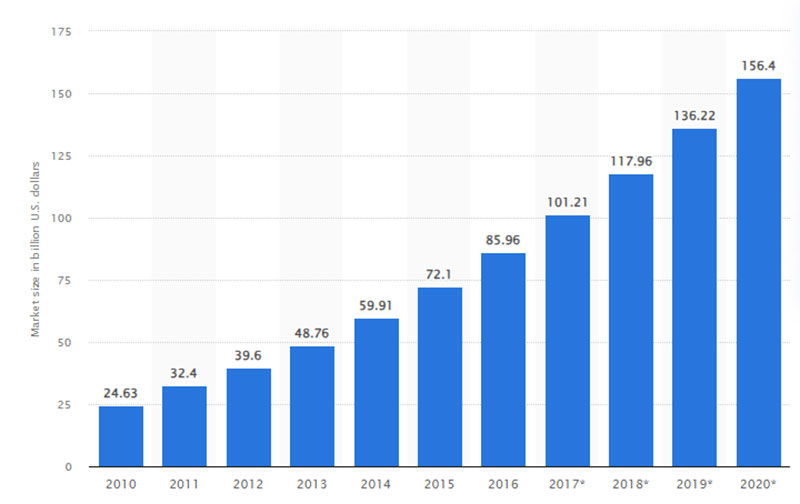Imagine stepping into a realm where growth charts soar, and the sky is quite literally the limit. Cloud computing statistics paint a vivid tableau of technological evolution, showcasing the relentless climb of digital infrastructures that redefine how businesses thrive.
In an era marked by instant access and global connectivity, these figures aren’t just numbers on a screen—they’re the pulse of progress, the rhythm of innovation.
This article unfolds the tapestry of data that trails behind the meteoric rise of cloud computing. You’ll be ushered into a domain where Saas data, virtualization impact, and cloud ROI coalesce to form a narrative of transformation.
As we navigate through the surge in cloud adoption rates and decode the undercurrents of cloud computing demand, you’re not merely absorbing information but defining the trajectory of how your digital canvas evolves.
By the conclusion of our exploration, you’ll have a fortified understanding of global cloud computing market, trends shaping cloud scalability, and insights from entities like Amazon Web Services and Microsoft Azure. Prepare to be immersed in the crux of the cloud’s numerical narrative—where complexity translates into clarity.
Market Size and Growth of Cloud Computing
The Cloud Market’s Meteoric Rise

- Explosive Growth: From a relatively modest $24.63 billion in 2010, the global cloud computing market rocketed to $156.4 billion by 2020, marking a staggering 635% increase. This trend is far from slowing, with predictions pointing to a market surpassing $1 trillion by 2028.
- Revenue Surge: In 2022, cloud infrastructure services alone generated a monumental $191 billion in revenues. This includes a diverse portfolio of Software as a Service (SaaS), Infrastructure as a Service (IaaS), and Platform as a Service (PaaS) offerings.
Dominant Forces in the Cloud Arena
- The Titans: AWS, Microsoft Azure, and Google Cloud Platform dominate the market, collectively holding a significant 66% share at the start of 2023. AWS leads with a 33% slice, followed by Azure’s 22% and Google’s 10%.
- Revenue Breakdown: Public cloud services hit an all-time high with revenues surpassing $415 billion in 2022. IaaS led the charge with $120.3 billion, followed by SaaS and PaaS making substantial contributions.
A Look Ahead
- Future Projections: By 2029, the cloud market’s valuation is expected to reach an astounding $376.36 billion. This growth is fueled by an insatiable demand for cloud services across all sectors, propelled by advancements in AI, machine learning, and big data analytics.
The Cloud’s Worldwide Impact
- Global Penetration: The cloud’s reach extends globally, with significant growth in both developed and emerging markets. North America and Western Europe currently lead, but Asia-Pacific, Latin America, and even Africa are catching up rapidly, each with unique growth drivers and challenges.
- Data Deluge: It’s estimated that by 2025, the world will store 200 zettabytes (2 billion terabytes) of data in the cloud, underscoring the cloud’s critical role in our digital future.
The Bottom Line
- Economic Juggernaut: Beyond the impressive numbers, the cloud’s true value lies in its transformative impact on businesses and societies worldwide. From enabling remote work to driving innovation in sectors like healthcare, finance, and gaming, the cloud continues to be a pivotal force in the digital age.
- Investment and Spending: With increasing cloud adoption, spending is on the rise. Enterprises and SMBs alike are dedicating a larger portion of their IT budgets to cloud services, striving for enhanced efficiency, scalability, and innovation.
Cloud Adoption Rates and Usage Patterns
The Landscape of Cloud Adoption
The shift toward cloud computing is undeniably accelerating, becoming a staple for both enterprises and individuals alike.
This transformation is largely fueled by the myriad advantages cloud computing offers, such as enhanced flexibility, scalability, and cost-efficiency.
Enterprise Adoption
- Widespread Utilization: More than 90% of organizations now employ cloud solutions, with a significant portion operating in a multi-cloud environment. This includes a mix of public and private clouds to optimize resources and enhance security measures.
- Strategic Shifts: Enterprises are increasingly moving toward cloud-first strategies, with nearly half planning to migrate over half of their applications to the cloud within a year. This reflects a keen interest in harnessing the cloud’s power for better scalability and innovation.
Small and Medium Businesses (SMBs) Engagement
- Growing Cloud Footprint: SMBs are also embracing cloud computing, with a noticeable uptick in cloud utilization. The trend towards cloud services is partly driven by the necessity for remote work capabilities and the desire for more agile business operations.
- Cost and Operational Benefits: For SMBs, the cloud presents an opportunity to compete on a larger scale, offering access to technologies and infrastructure that were previously out of reach due to high costs and complexity.
Usage Patterns and Preferences
Cloud computing’s versatility allows it to cater to a wide array of needs, from data storage and disaster recovery to application development and beyond.
Data Storage and Management
- Corporate Data in the Cloud: A significant portion of corporate data now resides in the cloud, highlighting the trust in cloud solutions for storing sensitive information securely.
- Personal Cloud Utilization: Billions of individuals rely on personal cloud services like Google Drive and Dropbox for storage and data sharing, underlining the cloud’s impact on everyday digital activities.
Service Provider Dominance
- Market Leaders: AWS, Microsoft Azure, and Google Cloud Platform lead the cloud service provider market, collectively holding a substantial share. Their dominance is a testament to the comprehensive range of services, reliability, and innovation they offer.
- Diverse Needs, Diverse Providers: While the big three are the most popular, other providers cater to niche markets or specific geographical regions, demonstrating the cloud market’s diversity.
The Future of Cloud Adoption
Cloud computing continues to evolve, responding to the changing needs of businesses and individuals alike. This evolution is evident in the increasing adoption rates, the strategic importance placed on cloud investments, and the continuous development of new cloud technologies and services.
Multi-Cloud and Hybrid Strategies
- Embracing Complexity: Organizations are increasingly adopting multi-cloud and hybrid cloud strategies to optimize their cloud investments. This approach allows them to leverage the best features and pricing models of different cloud providers, enhancing flexibility and resilience.
Cloud Security and Management
- Prioritizing Security: As cloud adoption grows, so does the focus on cloud security. Organizations are investing in advanced security measures and practices to protect their data and comply with regulatory requirements.
- Efficient Cloud Management: The rise in cloud utilization has also brought attention to cloud cost management and optimization. Enterprises are seeking tools and strategies to monitor and control their cloud spending effectively, ensuring they derive maximum value from their cloud investments.
Analysis of Cloud Service Providers
The cloud computing landscape is marked by fierce competition and rapid innovation, with several key players dominating the market. Here’s a comprehensive look at how the titans of cloud computing are shaping the industry.
Amazon Web Services (AWS)
- Market Leadership: AWS maintains a commanding presence in the cloud infrastructure market, consistently holding the largest market share. In the early part of 2023, AWS controlled approximately 33% of the market.
- Revenue Growth: AWS has witnessed steady revenue growth, with a reported annual increase that consistently surpasses the overall market growth rate.
- Service Expansion: AWS offers a vast array of services, over 200, including advanced machine learning, AI capabilities, and more, serving millions of customers globally.
Microsoft Azure
- Strong Contender: Azure has made significant strides, securing a market share of around 23% by the end of 2022. It stands as the second-largest cloud service provider.
- Market Share Gain: Microsoft Azure’s market share has been on the rise, reflecting its growing acceptance and usage among enterprises.
- Diverse Offerings: Offering over 600 cloud services, Azure caters to a wide range of computing needs, from virtual machines to AI and machine learning services.
Google Cloud Platform (GCP)
- Rapid Growth: GCP has demonstrated remarkable growth, with its market share reaching 11% by the start of 2023. It’s known for its strengths in deep learning, machine learning models, and comprehensive data analytics solutions.
- Revenue Increase: Google Cloud’s revenue has been increasing steadily, with significant year-on-year growth reported in recent quarters.
- Expanding User Base: Hosting over 1.42 million websites, Google Cloud serves a diverse clientele, including major companies like Spotify.
Emerging Trends and Developments
- Public Cloud Revenue Surge: The revenue from public cloud services witnessed substantial growth, with projections indicating further increases in the coming years.
- Infrastructure as a Service (IaaS): Amazon leads the IaaS segment with a significant revenue share, followed by other major providers contributing to a highly competitive landscape.
- Cloud Gaming Market Expansion: The cloud gaming market has seen exponential growth, with projections estimating a multi-billion dollar valuation in the near future.
Strategic Moves
- Multi-Cloud and Hybrid Strategies: Enterprises are increasingly adopting multi-cloud and hybrid cloud approaches, leveraging the strengths of different providers to optimize their cloud infrastructure.
- Focus on Cloud Cost Management: With the rising investment in cloud services, businesses are prioritizing cloud cost management to ensure efficient use of resources.
- Investment in Data Centers: The leading cloud service providers are continually expanding their global network of data centers to support the growing demand for cloud services.
Cloud Computing in Business
Cloud computing continues to revolutionize the business world, offering unprecedented flexibility, scalability, and opportunities for innovation. The content from the URLs provided offers a wealth of data and insights into how businesses are leveraging cloud technology today.
The Rising Tide of Cloud Adoption in Enterprises
- Broad Utilization: More than 90% of organizations now utilize cloud services, with a significant trend towards multi-cloud infrastructures combining public and private clouds for optimized resource utilization.
- Strategic Implementations: Nearly half of the enterprises plan to migrate over half of their applications to the cloud within the next year, underscoring the strategic pivot towards cloud-first and cloud-native approaches.
Cloud Infrastructure’s Economic Impact
- Market Expansion: The cloud computing market has seen explosive growth, with the global cloud infrastructure services market reaching $191 billion in recent reports. Amazon Web Services (AWS), Microsoft Azure, and Google Cloud Platform lead the pack, collectively holding a significant portion of the market share.
- Spending Insights: Organizations are increasingly aware of their cloud spend, with a focus on optimizing costs without sacrificing performance or security. Despite this, many companies still struggle with cloud cost management, pointing to an opportunity for improved financial governance in the cloud. This can include optimizing costs associated with auxiliary services such as understanding AWS backup pricing or content delivery networks.
The Shift Towards Multi-Cloud and Hybrid Solutions
- Diverse Strategies: The vast majority of businesses now employ a mix of cloud solutions, with a considerable shift towards hybrid and multi-cloud strategies. This approach allows organizations to leverage the strengths of different providers and reduce dependence on a single vendor.
- Innovation and Efficiency: Companies cite the desire for increased innovation, better disaster recovery, and the need to meet specific compliance and security requirements as key drivers for adopting multi-cloud environments.
Cloud’s Role in Enabling Remote Work
- Accelerated by the Pandemic: The global shift to remote work has accelerated cloud adoption, with cloud infrastructure supporting a wide array of remote work applications and collaboration tools.
- Future of Work: As companies adopt hybrid work models, the reliance on cloud computing is expected to increase, further cementing its role as a critical infrastructure component for modern businesses.
Cloud Security as a Paramount Concern
- Rising Threats: With an increasing portion of corporate data stored in the cloud, security remains a top concern. The complexity of managing security across multiple cloud services adds to the challenge, with companies investing in advanced security measures and practices to protect their data.
- Regulatory Compliance: Compliance with data protection regulations also drives cloud security efforts, as businesses must navigate a complex landscape of local and international laws governing data privacy and security.
The Growing Importance of Cloud Cost Optimization
- Financial Management: As cloud spending becomes a more significant portion of IT budgets, businesses are prioritizing cost optimization strategies to ensure they are getting the best value from their cloud investments. Tools and practices for monitoring and managing cloud spend are becoming more sophisticated, allowing businesses to reduce waste and allocate resources more efficiently.
Personal Cloud Usage Statistics
The digital universe is expanding, with clouds forming not just overhead but in the vast cyberspace, holding our data, memories, and so much more. Personal cloud usage has seen a meteoric rise, paralleling the exponential growth of data and the increasing reliance on digital solutions for everyday tasks.
The Digital Data Deluge
- Staggering Storage: By 2025, an estimated 200 zettabytes of data will reside in the cloud, a figure that’s hard to fathom yet speaks volumes about our digital dependency.
- Massive Migration to the Cloud: A whopping 60% of the world’s corporate data now calls the cloud home, showcasing the shift from physical storage to cloud solutions.
Popular Personal Cloud Services
- Google Drive Takes the Crown: Dominating the realm of personal cloud storage, Google Drive boasts an extensive user base, with its ease of use and integration with other Google services cementing its top spot.
- Dropbox’s Durable Appeal: Despite fierce competition, Dropbox remains a favorite for millions, valued for its simplicity and robust features that cater to both individual and business needs.
- iCloud’s Integrated Ecosystem: For those within the Apple universe, iCloud offers seamless integration, making it an indispensable part of the iOS and macOS experience.
Gaming on Cloud Nine
- Skyrocketing Sector: The cloud gaming market, valued at a modest $1.5 billion in 2021, is on track to reach over $6 billion by the end of 2024. This growth trajectory hints at a future where gaming transcends traditional hardware limitations, offering access to high-quality gaming experiences anytime, anywhere.
The Cloud’s Cost Conundrum
- Navigating the Nebulous: As cloud services become increasingly integral to personal and professional life, managing cloud expenses emerges as a formidable challenge for many. The quest for cost optimization and effective spend management is more pressing than ever, underscoring the need for greater transparency and control over cloud investments.
Cloud Computing from a Global Perspective
The cloud’s reach is truly global, encompassing every corner of the world, reshaping industries, and redefining how we interact with technology. Through the information drawn from comprehensive articles on cloud computing statistics, we observe a fascinating narrative of growth, challenges, and opportunities that span across continents.
Global Cloud Adoption and Market Growth
- Unstoppable Growth: The global cloud computing market is on a trajectory to surpass $1 trillion by 2028, demonstrating a monumental leap from $24.63 billion in 2010 to $156.4 billion in 2020. This staggering 635% jump is indicative of the cloud’s integral role in the digital transformation.
- Dominance of Major Players: Amazon Web Services (AWS), Microsoft Azure, and Google Cloud Platform collectively hold a significant portion of the market, with AWS leading at 33% market share in Q1 2022. These giants fuel the competitive landscape and innovation within the cloud sector.
- Public Cloud Services Boom: Public cloud service revenue has experienced explosive growth, with predictions estimating figures to reach $526 billion in 2023. This includes substantial revenues from Infrastructure as a Service (IaaS) and Platform as a Service (PaaS), underlining the extensive reliance on cloud services for business and personal use.
Regional Insights and Challenges
- Diverse Adoption Rates: Cloud adoption varies significantly across regions. Developed markets like North America and Western Europe lead in cloud utilization, but emerging markets in Asia-Pacific, Latin America, and Africa are catching up, driven by increasing digital transformation efforts.
- Infrastructure and Investment: Investments in cloud infrastructure and services are soaring globally, with significant spending on data centers to support the growing demand for cloud services. Countries are also focusing on regulatory measures to ensure data security and sovereignty, influencing cloud strategies and operations.
- Innovations and Expansions: Cloud service providers are continuously expanding their global footprint, launching new data centers, and innovating services to cater to a broader audience. This includes efforts to improve cloud accessibility, efficiency, and sustainability, addressing the evolving needs of businesses and consumers alike.
Sector-Specific Impacts
- Cloud Gaming’s Rise: The cloud gaming sector is witnessing rapid growth, with projections showing a market worth over $6 billion by the end of 2024. This represents a significant shift in the gaming industry, enabling on-demand gaming experiences across devices without the need for high-end hardware.
- Business Transformation: Cloud computing is revolutionizing businesses by offering scalable, flexible solutions that support remote work, enhance productivity, and drive innovation. Enterprises and SMBs alike are leveraging multi-cloud and hybrid cloud strategies to optimize their operations and foster growth.
- Security and Compliance: As cloud adoption escalates, so does the focus on security. Businesses and cloud service providers are implementing advanced security measures and complying with global data protection regulations to safeguard sensitive information and maintain user trust.
FAQ On Cloud Computing Statistics
How rapidly is the cloud computing market growing?
The cloud computing market is on an impressive trajectory, expanding briskly as businesses embrace digital transformation. With constant technological innovation, cloud services growth is robust, reflecting in the rising adoption rates among enterprises, big and small.
What percentage of businesses are utilizing cloud computing?
An increasing majority of businesses have migrated to the cloud, with cloud adoption rates suggesting that more than 90% of companies leverage some form of cloud service. This includes hybrid cloud figures, which indicate a blending of public and private cloud solutions.
What are the top benefits driving cloud computing adoption?
Primarily, cloud scalability and disaster recovery stand out as driving benefits. The ease of scaling operations and the assurance of data security propel businesses towards cloud solutions, while cloud ROI demonstrates the financial soundness of such transitions.
Who are the key players in the cloud computing industry?
Entities like Amazon Web Services, Microsoft Azure, and Google Cloud Platform dominate the landscape, offering a wide array of services. These titans lead in market share, innovation, and cloud infrastructure developments.
How secure is data in the cloud?
While no system is impregnable, cloud security statistics reveal a strong emphasis on the protection of digital assets. Providers invest heavily in defensive measures, ensuring that data privacy in the cloud is maintained, with GDPR compliance statistics serving as a stringent benchmark.
Are there cost advantages to using cloud computing?
Absolutely. One of the lures of the cloud is the cost savings it can offer, particularly in cloud computing costs related to infrastructure and maintenance. Cloud services allow for efficient budget allocation, often reflected in cloud ROI.
What is the role of AI and machine learning in cloud computing?
AI and machine learning stand at the forefront of cloud innovation. These technologies enhance cloud services, automating processes, and allowing for the intelligent analysis of data. Their integration is critical in the advent of smart, predictive cloud solutions.
How is cloud computing influencing remote work?
Amidst a global shift towards telecommuting, cloud computing has emerged as the linchpin for remote work. It has catalyzed cloud storage usage, empowered collaboration through SaaS data platforms, and ensured seamless access to work resources, irrespective of physical location.
What’s the future of hybrid and multi-cloud strategies?
The future heralds a rise in multi-cloud strategies and more intricate hybrid cloud figures, with businesses vying for the best of both worlds. This mix-and-match approach affords flexibility, cost-efficiency, and optimized performance, aligning with the diverse needs of modern enterprises.
What impact does cloud computing have on environmental sustainability?
Cloud computing exerts a dual impact on sustainability. On one hand, it concentrates resources within efficient data centers, potentially reducing the overall carbon footprint. On the other, the industry’s enormous energy consumption calls for green cloud computing initiatives and sustainable data center growth policies.
Conclusion
As our incursion into cloud computing statistics reaches its culmination, it’s apparent that this digital skyscape isn’t just expansive; it’s a complex ecosystem, punctuated by soaring cloud adoption rates and technological marvels like AI and machine learning.
- We’ve witnessed public cloud statistics tipping the scales, indicating a secured trust in cloud services growth.
- The global cloud computing market is a tableau of relentless innovation, where entities like AWS and Azure sculpt the horizon.
- Cloud ROI narratives tell tales of judicious investments and forespoken cost-efficiency.
Circling back to terra firma, we can stake the claim that cloud computing is no longer just a fleeting trend or a buzzword but a steadfast pillar in the architectural framework of modern enterprises. Its statistics are not mere digits; they’re the codified essence of a future unwaveringly anchored in the clouds. The bar charts and growth curves we’ve navigated are cardinal beacons, illuminating the path for tomorrow’s digital pioneers.
- TypeScript Today: What is TypeScript Used For? - April 27, 2024
- Professional Video: Cinematography Apps Like FiLMiC Pro - April 26, 2024
- Optimizing Your Shopify Store for Maximum Dropshipping Success - April 26, 2024









